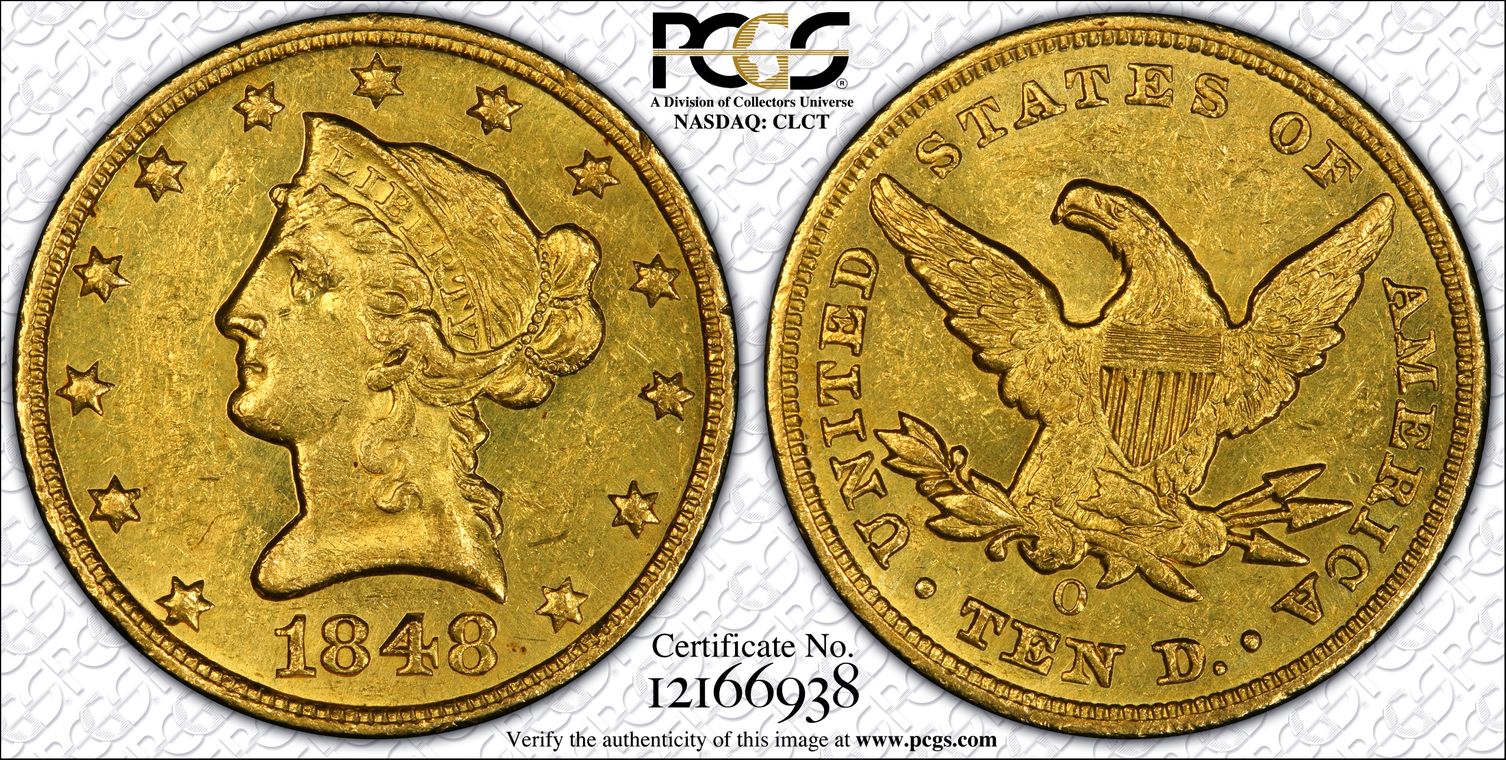1848-O $10 AU58 认证号12166938, PCGS号8600
专家评论
David Akers (1975/88)
The 1848-O is a rare date in any condition and it is particularly elusive in high grade. I have seen only two uncirculated pieces and perhaps five or six AU's; the rest have been only VF or EF. This date is of approximately the same rarity as the 1849-O and is more rare than any of the other O-Mint Eagles of this decade except the 1841-O to which it compares favorably except in high grade where the 1841-O is even more rare.Doug Winter
The 1848-O is a somewhat peculiar issue. In terms of overall rarity, it is one of the scarcer New Orleans eagles from the 1840s. But it is among the most available issues from this decade in higher grades and there are more very high quality (i.e. MS62 and better) 1848-O eagles known than nearly any other issue from this era.The typical 1848-O eagle grades VF to EF and examples in this range are not very hard to find. In AU50 to AU53, this date becomes very scarce and it is rare in AU55 to AU58. The 1848-O is very rare in Uncirculated although there are more very high grade pieces known than for any other New Orleans issue from the 1840s. This suggests that there may have been a very small hoard at one time.
STRIKE: The 1848-O has a distinctive appearance and it is similar to the 1849-O eagle in this regard. All known examples are weakly struck on the obverse with an almost sunken, semi-concave appearance. The E in LIBERTY is sometimes so weak that it is nearly illegible; this may be the result of a filled die. The radial lines of the stars are always very flat but the denticles are sharp. The reverse is better struck without the concave appearance seen on the obverse and good detail on the eagle’s feathers. The right leg and the wing tips often show incomplete detail.
SURFACES: Most 1848-O eagles are very heavily abraded on the surfaces. I have seen a number that have small reddish copper spots, particularly on the obverse and within the reverse lettering. Almost every 1848-O is heavily abraded in the fields, although the few very high grade pieces known have remarkably clean surfaces.
LUSTER: The luster is semi-prooflike and very different in appearance than on any other New Orleans eagle from this era. I have seen a few that were nearly fully prooflike but these had heavy abrasions and were not attractive. Many have been cleaned at one time and have dull, impaired luster as a result.
COLORATION: The coloration ranges from a deep green-gold to a lighter orange-gold hue. As recently as five years ago, it was not very hard to find a circulated example that was original. Today, most of these coins have been cleaned or dipped and attractive, original pieces are very scarce.
EYE APPEAL: The typical 1848-O eagle has below average eye appeal, primarily due to the peculiarities of strike mentioned above. Even higher grade pieces are lacking detail at the centers and on the radial lines of the stars. The surfaces are usually heavily marked and many have detracting abrasions in the obverse fields. There are a few exceptional examples known and one specific coin, ex: James Stack collection, is the single finest known business strike No Motto eagle from this mint.
DIE CHARACTERISTICS: There are peculiar die lapping lines that intersect in the obverse field in front of Liberty’s neck. Other die lapping lines can also be seen in the obverse fields around the portrait; these may fade out on lower grade pieces. There is a large patch of die file lines on the reverse at the eagle’s right shoulder, below the beak.
MAJOR VARIETIES: There are two die varieties known:
Variety One: The date is heavy and placed slightly high in the field. The 4 is closed. The mintmark is high in the field and placed over the EN in TEN. There is a punchmark on the reverse shield that is located on the third and fourth horizontal lines. This punchmark is different from that seen on the 1851-1852 eagles. The reverse lettering is heavy and there are die file lines at the eagle’s right shoulder as mentioned above.
This variety is always seen weakly struck and it is far more available than Variety Two.
Variety Two: The obverse is the same as on Variety One. The mintmark is placed slightly lower than on the other variety of this year. Reverse of 1847. There is no punchmark seen on the reverse and the die file lines seen on Variety One are not present. The lettering on the reverse appears lighter. Usually seen better struck than Variety One and very scarce.
PCGS #
8600
设计师
Christian Gobrecht
边缘
Reeded
直径
26.80 毫米
重量
16.70 克
铸币数量
35850
金属成分
90% Gold, 10% Copper
更高评级数量
14
评级较低的钱币数量
139
地区
The United States of America
价格指南
PCGS 数量报告
拍卖 - PCGS 评级的
拍卖 - NGC 评级的
稀有性和存量估计 了解更多
| 所有评级 | 200 |
| 60或以上 | 8 |
| 65或以上 | 1 |
| 所有评级 | R-7.0 |
| 60或以上 | R-9.6 |
| 65或以上 | R-10.0 |
| 所有评级 | 39 / 64 TIE |
| 60或以上 | 35 / 64 TIE |
| 65或以上 | 1 / 64 TIE |
| 所有评级 | 72 / 183 TIE |
| 60或以上 | 56 / 183 TIE |
| 65或以上 | 1 / 183 TIE |
状况普查 了解更多
| #1 MS66 PCGS grade |
|
#2 MS65 estimated grade
James A. Stack, Sr. Collection - Stack's 10/1994:1298, $154,000 |
|
#3 MS64 PCGS grade
Heritage 1/2015:4335, $51,700 |
| #3 MS64 PCGS grade |
| #3 MS64 PCGS grade |





















